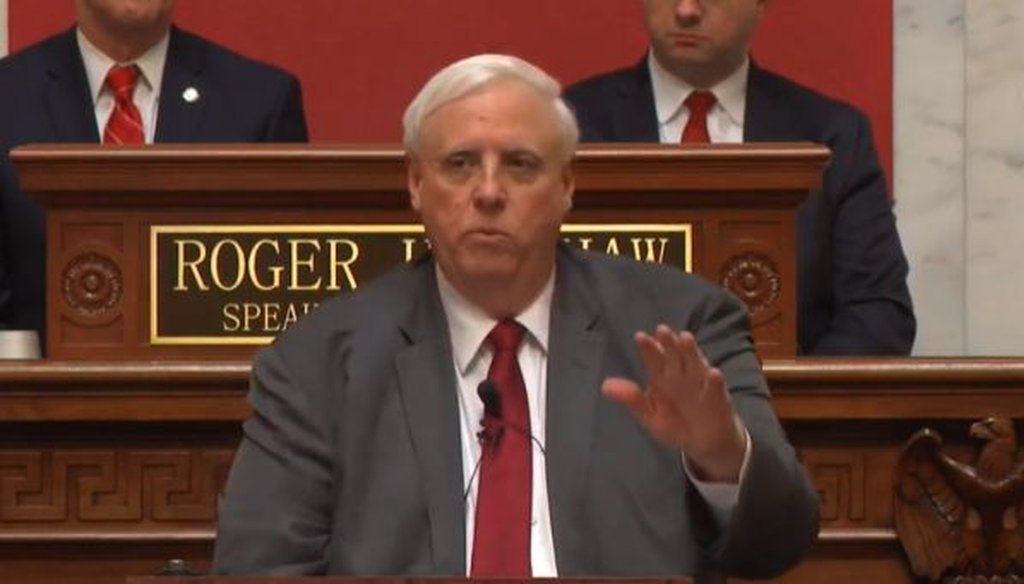Stand up for the facts!
Our only agenda is to publish the truth so you can be an informed participant in democracy.
We need your help.
I would like to contribute

Gov. Jim Justice of West Virginia, a Republican, gives his state of the state address on Jan. 9, 2019.
MORGANTOWN--Gov. Jim Justice delivered his third State of the State address tonight, proposing the elimination of a state tax on Social Security benefits, a 5 percent pay raise for state employees including teachers, and millions of dollars more for substance abuse and other social services.
PolitiFact West Virginia took a look at the accuracy of a few of Justice’s statements in the speech. We will analyze additional statements from the speech in the coming days.
Not exactly.
In October 2018, we looked at a similar claim by Justice -- "A little over one year ago I was sworn in as your governor. At that time, our state was bankrupt for all practical purposes." We ended up not providing a truth rating for that statement because it was hard for us to weigh the meaning of the phrase "for all practical purposes."
In the State of the State address, Justice offered no such qualification.
Justice was elected in November 2016 and was sworn into office on Jan. 16, 2017.
According to U.S. Census Bureau data released in 2016, West Virginia’s accumulated debt at that time was in excess of $7.2 billion. We’ll use this as a rough stand-in for the scale of the debt at the time Justice became governor.
The problem is that having debt -- even in the billions of dollars -- does not necessarily mean that a state is broke.
Dictionaries define "broke" as "having no money; bankrupt" and "without money; penniless."
That was not the case for West Virginia, which still paid its bills. Further, under federal law, it’s doubtful that a state would be allowed to declare itself bankrupt.
Credit agency ratings serve as a gauge of a state’s creditworthiness. West Virginia’s status wasn’t perfect, but it was also not at the bottom of the scale.
One of the main credit agencies, Standard and Poor’s, had West Virginia in both 2016 and 2017 at a rating of AA- on a scale of AAA to BBB-. That’s worse than many states, but the same as or better than others, including California, Connecticut, Illinois, Kansas, Kentucky, Michigan, New Jersey, and Pennsylvania.
And as a worst-case scenario, a state could always raise taxes to help pay its bills. (This would be politically unpopular, but it would be a way to avoid being unable to pay outstanding bills.)
We’ll use an analogy we’ve used previously: Your paycheck doesn't cover your bills every month, but you have a great credit score, you use your credit card to cover the difference, and have no trouble paying your credit card bill. Would you describe yourself as "bankrupt" or "impoverished"?
We wouldn't. We'd reserve that description for the neighbor who was behind on his mortgage and couldn't pay his creditors.
"As long as the state can service its debt, it is not bankrupt," said Brian Lego, a research assistant professor for economic forecasting at West Virginia University. "The state was in difficult financial circumstances at the time (of Justice’s statement) due to the downturn in coal and weakness in natural gas. But it was not bankrupt."
This appears to be correct.
On the eve of the State of the State speech, the governor’s office announced that collections for fiscal year 2019 were $185.9 million above estimates, producing "the biggest surplus in the state's history during the first six months of any fiscal year."
According to the state Education Department’s county-by-county graduation statistics web page, Greenbrier County -- where Justice lives -- had an 89.97 percent four-year graduation rate and a 90.88 percent five-year graduation rate. Neither is as high as 100 percent.
As we noted in our initial report, we reached out to the governor’s office for clarification and said we would adjust the article as needed. On Jan. 12, the governor's office told us that Justice had been referring specifically to the Communities in Schools program in Greenbrier County. His office said that high-school seniors in that program have a 100 percent graduation rate.
We have rated a similar statement by Justice Mostly True. He had said that the state’s tourism industry "grew at a rate 30 percent above the national rate in 2017."
According to a West Virginia Press report published in the Herald-Dispatch, the data came from the 2017 West Virginia Travel Impacts study undertaken by the firm Dean Runyan Associates. The study was prepared on behalf of the state tourism office.
In the nation as a whole, the report found, spending by resident and foreign visitors increased by 3.0 percent over 2016. In West Virginia, by contrast, total travel spending increased by 3.9 percent.
If you do the math, 3.9 percent is 30 percent higher than 3.0 percent.
That said, it’s worth noting that Justice highlighted the most favorable data in the report. He chose not to highlight the fact that, according to the report, local tax revenue from tourism fell by 2.7 percent over the same period, while state tax revenue fell by 1.2 percent.
Justice isn’t kidding when he said he’s pleaded with West Virginians to buy E-ZPasses.
In August 2018, he tweeted, "BIG SAVINGS: I promised a great E-ZPass deal and here it is. Thousands of folks are opening West Virginia E-ZPass accounts, and you can join them! If you sign up now, your plan will automatically transition to the $24 three-year plan in September."
In October, we looked at whether he was right that "thousands of folks are opening West Virginia E-ZPass accounts."
Dalphord W. Webb, director of customer service operations for West Virginia E-ZPass, told PolitiFact West Virginia that "from August 1 through October 15, there were 13,630 new West Virginia E-ZPass accounts opened."
If you prorate the number of new accounts that would have been opened between August 1 and August 27 -- the day of Justice’s tweet -- it works out to a bit under 5,000. That still counts as "thousands."
We rated the statement True.
EDITOR'S NOTE, Jan. 12, 2019: This article has been updated to reflect additional information provided by Justice's office about the graduation rate in Greenbrier County.
Our Sources
Sources linked in article.












































